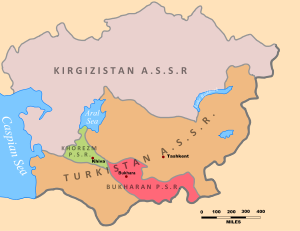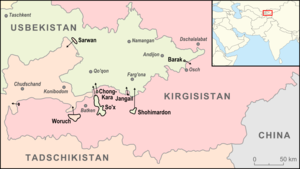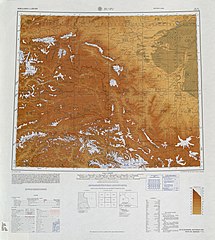
The border between Kyrgyzstan and Tajikistan is 984 kilometres (611 mi) long and runs from the tripoint with Uzbekistan to the tripoint with China.
Description
The border starts in the north at the tripoint with Uzbekistan in the Ferghana Valley. The border proceeds roughly westwards, with a sharp Tajik protrusion at the town of Chorku; it almost reaches the Kayrakkum Reservoir, however a thin strip of Tajik territory lies between the reservoir and the border. It then turns southwards near the Tajik enclave of Kayragach before turning sharply eastwards upon reaching the Turkestan Range. The border then follows this range, and the Alay and Trans-Alay ranges, eastwards to the Chinese tripoint.
Exclaves
On the border there are two Tajik exclaves within Kyrgyzstan: Vorukh and Kayragach.
History
Main article: National delimitation in the Soviet Union § National delimitation in Central Asia
National Territorial Delimitation (NTD) of the area along ethnic lines had been proposed as early as 1920. At this time Central Asia consisted of two Autonomous Soviet Socialist Republics (ASSRs) within the Russian SFSR: the Turkestan ASSR, created in April 1918 and covering large parts of what are now southern Kazakhstan, Uzbekistan and Tajikistan, as well as Turkmenistan, and the Kirghiz Autonomous Soviet Socialist Republic (Kirghiz ASSR, Kirgizistan ASSR on the map), which was created on 26 August 1920 in the territory roughly coinciding with the northern part of today's Kazakhstan (at this time Kazakhs were referred to as 'Kyrgyz' and what are now the Kyrgyz were deemed a sub-group of the Kazakhs and referred to as 'Kara-Kyrgyz' i.e. mountain-dwelling 'black-Kyrgyz'). There were also the two separate successor 'republics' of the Emirate of Bukhara and the Khanate of Khiva, which were transformed into the Bukhara and Khorezm People's Soviet Republics following the takeover by the Red Army in 1920.
On 25 February 1924 the Politburo and Central Committee of the Soviet Union announced that it would proceed with a policy of NTD in Central Asia. The process was to be overseen by a Special Committee of the Central Asian Bureau, with three sub-committees for each of what were deemed to be the main nationalities of the region (Kazakhs, Turkmen and Uzbeks), with work then exceedingly rapidly. There were initial plans to possibly keep the Khorezm and Bukhara PSRs, however it was eventually decided to partition them in April 1924, over the often vocal opposition of their Communist Parties (the Khorezm Communists in particular were reluctant to destroy their PSR and had to be strong-armed into voting for their own dissolution in July of that year).

The border assumed its current position in 1929. The Kara-Kirghiz Autonomous Oblast was originally within the Russia SSR in October 1924, with borders matching those of modern Kyrgyzstan. In 1925, it was renamed the Kirghiz Autonomous Oblast in May 1925, then became the Kirghiz ASSR in 1926 (not to be confused with the Kirghiz ASSR that was the first name of Kazak ASSR), finally becoming the Kirghiz SSR in 1936.
The Soviets aimed to create ethnically homogeneous republics; however, many areas were ethnically mixed (e.g. the Ferghana Valley), and they experienced difficulties in assigning a 'correct' ethnic label to some peoples. In spite of this, regional elites strongly argued in favour of strict delineation, and was further complicated by a lack of expert knowledge and paucity of accurate or up-to-date ethnographic data on the region. Furthermore, NTD also aimed to create 'viable' entities, with economic, geographical, agricultural and infrastructural matters unrelated to (and sometimes trumping those of) ethnicity.
International border
See also: 2021 Kyrgyzstan–Tajikistan clashes and 2022 Kyrgyzstan–Tajikistan clashesYou can help expand this section with text translated from the corresponding article in German. Click for important translation instructions.
|
The boundary became an international frontier in 1991 following the dissolution of the Soviet Union and the independence of its constituent republics. There were tensions in the post-independence era over border delimitation and policing, and especially after an Islamic Movement of Uzbekistan (IMU) incursion into Kyrgyzstan from Tajik territory in 1999/2000. At present border delimitation is ongoing.
This tension has led to conflict, primarily over access to resources within each nation's territory, especially in regards to water. As early as 2004, border clashes between Kyrgyzstan and Tajikistan were being discussed by local media, with over 70 border incidents being reported from 2004 to 2015. This conflict then escalated into a three-day battle in April–May 2021, which killed 55 people and forced over 33,000–58,000 Kyrgyzstan civilians to evacuate from the Batken Region. Clashes between Kyrgyzstan and Tajikistan became increasingly frequent throughout 2022, culminating in a 14–20 September confrontation that caused 137,000 Kyrgyz civilians to flee the border area.
Border crossings
- Batken (KGZ) – Isfara (TJK) (road)
- Kulundu (KGZ) – Ovchi Kalacha (TJK) (road)
- Madaniyat (KGYZ) – Madaniyay (TJK) (road)
- Karamyk (KGZ) – Daroot Korgan (TJK) (road)
- Bor-Döbö (KGZ) – Kyzylart (TJK) (road)
Settlements near the border
Kyrgyzstan
Tajikistan
- Lakkon
- Kulkent
- Navgilem
- Isfara
- Surkh
- Chorku, Tajikistan
- Shurab, Tajikistan
- Qistaquz
- Ghafurov
- Mehrobod
- Mujum
- Dakhkat
- Rosrovut
History maps
Historical English-language maps of the Kyrgyz SSR-Tajik SSR border, mid to late 20th century:
See also
References
- CIA World Factbook – Kyrgyzstan, 23 September 2018
- Bergne, Paul (2007) The Birth of Tajikistan: National Identity and the Origins of the Republic, IB Taurus & Co Ltd, pg. 40-1
- Starr, S. Frederick (ed.) (2011) Ferghana Valley – the Heart of Central Asia Routledge, pg. 105
- Bergne, Paul (2007) The Birth of Tajikistan: National Identity and the Origins of the Republic, IB Taurus & Co Ltd, pg. 39
- Edgar, Adrienne Lynn (2004) Tribal Nation: The Making Of Soviet Turkmenistan, Princeton University Press, pg. 55
- Bergne, Paul (2007) The Birth of Tajikistan: National Identity and the Origins of the Republic, IB Taurus & Co Ltd, pg. 42
- Edgar, Adrienne Lynn (2004) Tribal Nation: The Making Of Soviet Turkmenistan, Princeton University Press, pg. 54
- Edgar, Adrienne Lynn (2004) Tribal Nation: The Making Of Soviet Turkmenistan, Princeton University Press, pgs. 52-3
- Bergne, Paul (2007) The Birth of Tajikistan: National Identity and the Origins of the Republic, IB Taurus & Co Ltd, pg. 92
- Starr, S. Frederick (ed.) (2011) Ferghana Valley – the Heart of Central Asia Routledge, pg. 106
- Khalid, Adeeb (2015) Making Uzbekistan: Nation, Empire, and Revolution in the Early USSR, Cornell University Press, pg. 271-2
- Edgar, Adrienne Lynn (2004) Tribal Nation: The Making Of Soviet Turkmenistan, Princeton University Press, pgs. 56-8
- Bergne, Paul (2007) The Birth of Tajikistan: National Identity and the Origins of the Republic, IB Taurus & Co Ltd, pg. 55
- Rahim Masov, The History of the Clumsy Delimitation, Irfon Publ. House, Dushanbe, 1991 (in Russian). English translation: The History of a National Catastrophe, transl. Iraj Bashiri, 1996
- Haugen, Arne (2003) The Establishment of National Republics in Central Asia, Palgrave Macmillan, pg. 167
- ^ Bergne, Paul (2007) The Birth of Tajikistan: National Identity and the Origins of the Republic, IB Taurus & Co Ltd, pg. 44-5
- Edgar, Adrienne Lynn (2004) Tribal Nation: The Making Of Soviet Turkmenistan, Princeton University Press, pg. 47
- Edgar, Adrienne Lynn (2004) Tribal Nation: The Making Of Soviet Turkmenistan, Princeton University Press, pg. 53
- Bergne, Paul (2007) The Birth of Tajikistan: National Identity and the Origins of the Republic, IB Taurus & Co Ltd, pg. 43-4
- Starr, S. Frederick (ed.) (2011) Ferghana Valley – the Heart of Central Asia Routledge, pg. 112
- Trofimov, Dmitriy (2002), Ethnic/Territorial and Border Problems in Central Asia, retrieved 28 October 2018
- International Crisis Group (4 April 2002), CENTRAL ASIA – BORDER DISPUTES AND CONFLICT POTENTIAL (PDF), retrieved 28 October 2018
- Asia-Plus (3 March 2018), Tajikistan, Kyrgyzstan expected to resume border talks in the second half of March, archived from the original on 4 November 2018, retrieved 4 November 2018
- ^ Kurmanalieva, Gulzana (2018). "Kyrgyzstan and Tajikistan: Endless Border Conflicts". L'Europe en Formation. 385 (1): 121–130. doi:10.3917/eufor.385.0121 – via Cairn.info.
- ""Абрикосовая" война на кыргызо-таджикской границе" [Apricot War on the Kyrgrz-Tajik Border]. AKIpress News Agency (in Russian). 9 March 2004.
- "Kyrgyzstan-Tajikistan: Images of destruction after border clashes". BBC News. 2 May 2021. Retrieved 2 May 2021.
- "33,388 Kyrgyzstanis evacuated from conflict zone in Batken". Trend.Az. 2 May 2021.
- ^ Sultanalieva, Syinat (21 September 2022). "Kyrgyzstan-Tajikistan border clashes prove deadly for civilians". Human Rights Watch.
- "Two civilians killed as guards clash at Kyrgyz-Tajik border". Al Jazeera. 28 January 2022.
- "Kyrgyzstan, Tajikistan Hold New Talks After Shooting At Border Leaves One Dead". Radio Free Europe / Radio Liberty. 10 March 2022.
- "Tajikistan accuses Kyrgyzstan of provoking latest border clash". Reuters. 4 June 2022.
- ^ Caravanistan – Kyrgyzstan border crossings, retrieved 23 September 2018
| Borders of Kyrgyzstan | |
|---|---|
| Borders of Tajikistan | |
|---|---|


